|
FAQs on Marine Environmental Disease/Losses
13
Related Articles: Environmental Disease, Establishing Nutrient
Cycling, Marine Water Quality, Maintenance,
Related FAQs: Marine
Environmental Disease 1, Marine
Env. Disease 2, Marine Env.
Disease 3, Marine Env. Disease
4, Marine Env. Disease 5,
Marine Env. Disease 6, Marine Env. Disease 7, Marine Env. Disease 8,
Marine Env. Disease
9, Marine
Env. Disease 10, Marine Env.
Disease 11, Marine Env. Disease 12, & FAQs on
Environmental Disease By Cause/Types: Environmental Deficiencies, Oxygen/Gas Problems, Poisoning, Mis-stocking: Psychological Challenges, (
Aggressive
Behavior, Territoriality, ),
Physiological
Challenges (e.g. Metabolites, Allelopathy, Stinging), &
Troubleshooting/Fixing,
|
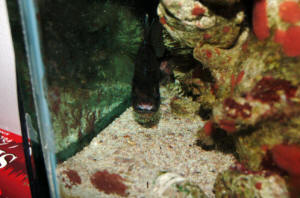
|
|
Salt water fish tank problems; cycling/env.
12/14/19
Hello,
My name is Mason,
<Hello Mason, Wil here.>
I have a salt water fish tank that has been problematic from the start (July
2019) despite everything we have tried to fix it, but our fish keep getting sick
and die.
<Did you cycle this tank?>
We started with a 29 gallon bio-cube tank some live rock, sand and salt water
from one specific store.
<Live, cured?>
We then found another store where we had gotten a watchman gobi <Y> and a royal
gramma to start our tank.
<These fish are not adequate to cycle a tank>
About 10 days later the gramma passed away.
<Did you quarantine the fish?>
After further water testing trace amounts of copper was found in the water. We
then called the original store and found out that their live rock supply is
mostly from broken down tanks.
<Mmm… I see>
We immediately removed the old rock and treated the tank with Triton Detox
(recommended from the new fish store) and a poly filter for after treatment. We
have had weekly to bi-weekly water testing all of which the parameters have been
good.
<Could you please send us the current test readings?>
We do bi-weekly water changes and test the salinity often, we have a protein
skimmer and heater in the tank that is set to 79.3 degrees. The problem that is
still occurring is that fish keep passing away. The watchman
gobi is still alive but since the first royal gramma we have lost 2 more and 2
bi-colored blennies, 2 peppermint shrimp, 1 tail spot blend, 1 carpenter wrasse,
1 cleaner shrimp, 1 coral beauty and countless Nerite snails all of which have
lasted for 3 weeks then perished. We had a Banggai cardinal fish that was
returned to the store because we thought maybe he was being a bully and put in a
Talbots damsel. The damsel we have now is currently growing some kind of fungus
on it and we really can not figure out what is happening to the tank, the
parameters are always good the salinity is fine, no one is being a bully. Our
current tank occupants are the watchman gobi, pistol shrimp, Talbots damsel, 2
turbo snails hermit crabs and Nerite snails. We also have coral that is doing
fine, growing and flourishing. Basically we are at an impasse and have invested
a lot of time and money into this tank and its been stressful and we are about
ready to give up.
<You should have invested more in reading ahead of buying fish.>
We recently tried General Cure by API but there is no change. We have a carbon
filter and a poly filter in the tank currently. I have attached a photo of the
damsel. If there is anything else that we can do please let us know
<I recommend you stop adding new livestock and do a good reading, please start
with the following links and related
http://www.wetwebmedia.com/estbiofiltmar.htm>
Thank you
Mason Truelove
<You are welcome. Wil.>
|
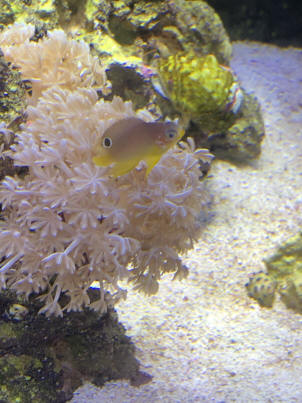 |
Thermal shock symptoms
12/5/19
Hey bob,
<Bobby>
Could you tell me what some of the symptoms of temp shock are?
<Most often, fishes (and invertebrates) "sink" to the bottom, low to in-active,
fins clamped... give up eating>
Did a water change on my quarantine tank last night. About 75 percent on 20
gallons to get meds out.
In my new water , I had heater in there set for same temp, and did water change.
(78)
After I did change, my tank temp dropped from 78 to 72,turns out I never had
heater plugged in and assumed it was on and close to temp.
I have a bellus angel laying on ground, and a watanabei swimming vertically.
Does that sound like temp shock, and if so is it too far gone at this point?
Thanks, Bobby
<Mmm; I would not give up. This degree of change does occur in the wild at
times. Bob Fenner>
Re: Thermal shock symptoms
12/5/19
Thanks bob. Just to clarify, the new water change water must have been in the
60s, because my display tank instantly went from 78 to 72, 6 degree drop in a
matter of 20-30 seconds.
<Yeah; have been out diving when very much colder water flowed out of rivers,
lagoons... happens>
Looking now I doubt the bellus has a chance, laying in side hasn’t moved really
and gills are moving. The watanabei will go from completely upright at the
surface , swim fine for a few minutes, and head back the vertical position.
<These shocks take a while (days, weeks) to correct. I like a model of
impairment of protein/enzyme function... >
I’ve had far worst luck with quarantine then the days of dipping and dropping
display .
<Patience. BobF>
Thanks again.
Re: Thermal shock symptoms
12/5/19
Hey bob, sad to report both fish did not make it. Came home from work and they
were dead on the bottom.
<Ahh!>
Is it safe to blame the temp drop? My fear is something else was a miss, ad this
just out the nail in the coffin. Or could it very well be some fish just can’t
handle the drop?
<As previously stated/postulated, the thermal drop/stress is likely a
complimentary negative influence here; along w/ some other factor/s; this did
likely lead to their loss. Bob Fenner>
Elegance coral, dying in/comp.
11/18/18
My Elegance Coral died so I removed it and did a water change. Same
night I lost 80% of snails then 5 days later 2 clowns and a blenny
started to act funny then passed. Do you think the Elegance dying could
have created that or a chemical. (all crabs and shrimps not affected)
<Almost certainly it was caused by toxins released by your Elegance
coral dying; do a large water change,40-50% and use a Polyfilter pad
combined with a high grade activate carbon or ChemiPure, a couple of
days later try adding some "test" fishes like bluetail Damsels
(Chrysiptera sp). Please keep us posted on how it goes. Wil>
Question about transferring marine fish
11/15/18
Dear Crew:
<Cynthia>
I read your website and questions and answers all the time.
I think you folks are fantastic.
<Well, Thanks!>
I have just one question, and I have read a lot of conflicting information about
it.
<Will do my best to dispel any doubt>
I don’t have any tanks set up at this time, but after many years of freshwater
experience and breeding cichlids, I am starting to set up a saltwater aquarium.
This is my question: regarding marine fish, if you have to transfer a fish from
one tank to another or from the bag he/she came in to a tank, and you’re in a
hurry (let’s just say the sky is falling) what parameter is the most important
to match between the water you’re moving from and the water you’re moving to?
Is
it the salinity or the pH or both or temperature or something else?
<The three of them are very important, but I would say Ph adjustment is the most
critical, since this parameter is the one that causes stress shock in newly
acquired/acclimated fish; secondly I will put salinity, fish are reasonably
tolerant to slight variations. And lastly, water temperature; this one may be a
bit different (preferably warmer) than the water containing the fish.>
Thanks very much,
Cynthia White Vancouver Island
<Welcome. Wil>
|
Good morning....flame Hawkfish has a lump just before his
tail what could this be?
6/17/18
<Mmm; a cyst, tumor... bacterial, cancerous? Do you have a good pic of a few
hundred Kbyte size?
Bob Fenner>
Re: Flame Hawkfish, bump 6/21/18
<... six megs... nonsense. >
This appears to be a growth response to a physical injury. Good care, use of
HUFAs, vitamin soaking foods, water quality minding... is a/the path to
resolution. BobF>
Re: 6/21/18
Thank you
<Welcome>
|
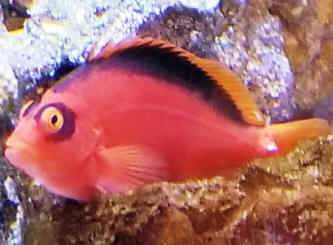 |
|
Ammonia poisoning, after-care and prognosis
4/9/17
Hi crew! I recently had an unfortunate incident of spiking ammonia during a
prophylactic QT of three wrasses. The wrasses included two fairy (Jordani,
rhomboid) and a juvenile Meleagris leopard.
Background of QT process: The first week of QT was spent in a cycled tank with
live rock for acclimation and training the leopard to accept prepared foods.
After the leopard began readily accepting various foods, two doses
of Praziquantel were administered 6 days apart for suspected gill flukes.
Also, 10 days of MetroPlex/focus-bound food after observing white-stringy waste
from the Jordani. Both treatments concluded without complications, however the
Jordani was still scratching and showing symptoms of gill irritation so I
decided to execute a tank transfer regime to address the possibility of
crypto/ich in the gills.
<Good practices...>
The tank-transfer treatment was successful, by the second transfer all flashing
and symptoms were gone. The fish tolerated the remainder of the treatment well,
and all three continued to eat heartily after each of the
four transfers and appeared very healthy. The total time spent in QT was a
little over 4 weeks.
The incident occurred the day after the last transfer. I had intended to observe
the fish for a few more days to make sure no new symptoms would appear. But, the
following day I noticed some clouding on the tail-fin of
the rhomboid. I used a liquid ammonia test and was horrified to see the ammonia
had jumped up to 1ppm overnight!
Since all of the treatments were complete, I quickly decided the best course of
action would be to move them to the display tank and out of the toxic water.
<This is what I'd have done as well>
Once in the display, I noticed the two fairy wrasses showed some physical
symptoms of ammonia burns- tattered/cloudy fins and "scuffed" scales. I probably
should have administered a Methylene blue blue bath for toxicity, but at the
time I just wanted them in clean water as quickly as possible.
This was three days ago, the leopard wrasse never showed any physical or
behavioral symptoms of distress, the rhomboid swam near the surface for the
first night but has since resumed normal behavior and its fins and physical
symptoms are almost completely healed. The jordani unfortunately does not look
much better. Still has cloudy/tattered fins and "burns" on its sides.
<David Starr Jordan's wrasse is the weaker of the Cirrhilabrus here>
I can't capture the burns with my camera, but the scales are whitish in color
and look kind of raised. He is eating well, and active.
<Ah, good>
He is favoring the left fin (with the most damage) and not using it much to
swim. Is there anything I can/should do at this point to help him recover,
besides feeding vitamin-enhanced foods?
<Nothing else that I would do; no>
Should I be concerned that a secondary infection might be at play?
<Mmm; more harm potentially to move, treat at this juncture. I'd leave in place>
I have multiple QT tanks available if it would be advisable to get him into a
cycled hospital tank for observation and/or antibiotics. Catching him may be
tricky, but he's a pig so a trap might work fairly quickly.
Thanks in advance, sorry for the long note but I wanted to provide as much
background information as possible.
Nicole
<Thank you. Bob Fenner>
Re: Ammonia poisoning, after-care and prognosis 4/9/17
Sorry, total QT was a little over 5 weeks...not 4. I misread the calendar.
Not that it's pertinent to the question at hand, but for archival purposes.
<Cheers, BobF>
Re: Ammonia poisoning, after-care and prognosis 4/9/17
Thank you, Bob. I'll stay the course and hope for the best. Enjoy your weekend!
<And you Nicole. B>
Re: Ammonia poisoning, after-care and prognosis. Cirrhilabrus f'
4/11/17
Quick update, he's looking much better. I think he's well on the mend.
Thanks for your help!
<Ahh; good. BobF>
|
 |
|
Fwd: pictures of strange ailment.
10/24/16
No..... am in Mexico. Can't download ten megs of pix. SEE and HEED our
requirements.... hundreds of kilobytes... and please RESEND. BobF
Re: Fwd: pictures of strange ailment.
10/25/16
Y dos.
My Guy emailed these to me today. I see now that the files are about one
megabyte each. Hopefully that'll be ok!
-Matt
<Yeah; just took a shower while downloading. En futura, please crop. B>
Re: Fwd: pictures of strange ailment.
10/25/16
Lo siento...
<Por (Ralph) nada (Nader)>
Ahoy Bob and friends,
<Matt>
I've got myself a head scratcher with a raccoon butterfly and a Flagfin
angelfish. As you may be able to see from photos, first raccoon showed skin
irritation, followed by protruding white growths around rostrum.
Weeks later the Flagfin angelfish is showing same.
<See this.... whitish growths>
Living peacefully in a community of largish fish. No Visible aggression.
And still eating well.
They are Living in a fish only 250 gallon @1.011,
<Know of other folks in the trade who mainting FO systems at such low spg's...
not a fan: TOO stressful>
pH of 8.1. daily vinegar dosing to remedy nitrate. Some Kalkwasser mixed
into top off water for
pH.
Bi weekly 60 gallon water changes. Fed large blend of flake pellet and frozen
daily.
Any ideas? Fungal maybe?
<Environmental I'd list as principal cause... like Lymphocystis. I'd
move the mal-affected fishes to a higher specific gravity setting sans NO3
issue. Bob Fenner>
|
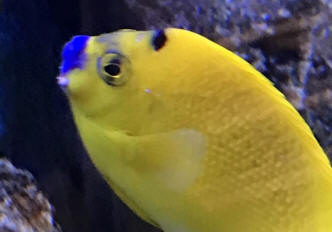
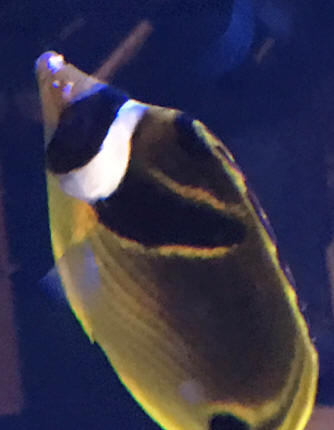 |
|
Re: Fwd: pictures of strange ailment. 10/26/16
Thanks for the comeback Bob.
<W>
So ideally, yes I'd raise their salinity. However three weeks ago I pushed above
1.0013 and got a Cryptocaryon outbreak immediately. Tank had been at 1.008 for 3
months to attempt to remedy deadly outbreak caused by unquarantined fish
(against my recommendation).
<Time for CP...>
Nitrate has lowered from above 100 to currently 25 as per Salifert.
I'm considering capture and treatment of affected fish in quarantine tank.
<This issue will best resolve/solve itself over time in a large, established
main/display system. REDUCE stress, add vitamins, HUFAs, probiotics to foods,
and be patient. BobF>
Re: Fwd: pictures of strange ailment. 10/26/16
Little further discussion-
<Good>
I'm going to have to disagree with regards to hypo and CP. After three years
experience using hypo, and about 9 Months using CP, I dropped CP from my
arsenal. Too unreliable without effective accurate testing for therapeutic vs.
lethal vs. ineffective.
<Ahh>
My assistant and myself combined found that it killed 6 out of 6 hippo tangs.
However hypo has been a miracle symptom eraser.
<Symptom; not cause>
We recognize that its more of a stall than a cure, but it has worked every time
at preventing mortalities, and seems to make reef fishes less stressed rather
than more.
-Matt
<A fave approach as mentioned earlier; esp. for Lance Ichinotsubo. Bob Fenner>
|
Emergency situation
11/12/15
I just did something really stupid trying to do good, and I'm trying to save my
fish.
I had a friend that was suppose to be tending my aquarium while I was away for
several months, but I came home to a disaster! There was green looking (wipes
off black though) allege <algae likely> all over the sides of the tank and
growing
on the rocks.
<Did this material feel especially slimy? Indicative of Cyanobacteria/BGA>
Thus, I try to wipe fine the sides of the tank only to realize that the
filtration pump had gone out; now there us debris
floating all through the water, and one of the fish seems to be in a panicked
distress. (I already had a bubble stone in the tank so there is oxygen running.
My thoughts are to add some of the established water into a bucket that has 2
1/2 gallons of saltwater, and live <move?> the bubble stone and fish into the
bucket temporarily rather than leaving them to try to breathe with the floating
debris while can get the tank clean and replace its filtration system. Would
that work to save the fish, and how much established water
would need to be added to the saltwater?
<Can't say; but.... often such "debris" includes material (the aforementioned
Blue Greens) that are toxic... better to change out a good deal of the system
water, add activated carbon, other chemical filtrants>
I'm now panicked myself, and would appreciate a quick response. I've had these
fish for a couple of years now and really don't want to lose them.
Thanks for your help.
Panicked in Texas
<Sorry re the lateness of this response. Just got up here. Bob Fenner>
re: Emergency situation 11/13/15
The stuff on the glass had bristle worms all in it and seemed alive (growing),
so I did not touch it with my bare hand to know if it was slimy;
<Ahh!>
the stuff on the bubble stone was grey and extremely slimy looking when I wiped
it off.
<I see>
Due to no quick response, I went ahead and added about 2 gallons of established
water, the heater, and the bubble stone into the bucket and moved the fish there
for now. That way I can sift the sand some, scrub the glass thoroughly, remove
the rocks, and get a filter on it without harming the fish. The nitrates were
really high already despite frequent water changes.
>//// best to get all back in the main display ASAPractical... more stable.
BobF<
re: Emergency situation; not reading, using WWM.... Polychaete comp.
11/14/15
I began cleaning today and it seems removing the heat or (and) oxygen has
brought most of those nasty bristle worms out of the sand; there are probably
50+, maybe a hundred, many an inch long.
<Not a problem. >
The surface of the sand is covered with them; makes me want to dump that sand
and start all over.
Is that feasible?
<Why? READ here:
http://www.wetwebmedia.com/polychaewmcompfaq2.htm
(Fish are still alive after two days in the bucket.) Let me know on that one,
okay? Thanks.
<Move them back as I've already stated. BobF>
Identifying parasite or bacterial infection
11/10/15
Hello crew,
<Hi ya Doug>
I am having a pretty rough time identifying the parasite or bacterial infection
that is present in my Fowlr tank. I have a 60 gallon with a Kole Tang, 3
Firefish, a 3 stripe damsel, some hermits and turbo snails, and a skunk cleaner
shrimp.
<Ohh, my usual blanket statement re such diagnoses: Can ONLY be done via
sampling and looking under a microscope; and even then, at times difficult>
The Kole tang and damsel are pretty regularly scratching themselves
against the rocks, <Not necessarily indicative of pathogen involvement... akin
to you and I, sometimes the environment makes us itchy>
and I lost a Klein butterfly yesterday after who was also flashing. The Klein
and Kole were pretty consistently floating near the shrimp to ask for cleaning,
but for some reason he was hesitant but occasionally did abide. The only
physical signs I see, aside from flashing, are present on the Kole which are
really dark circles on his side, one small one near his eye, and on one of his
side fins. The damsel looks as he always has, but is scratching regularly. I
also noticed one of the fire goby's starting to scratch as well.
My pH is at 7.9.
<Ohh, this is low.... too low. The pH scale is base ten logarithmic... like some
others in the physical world... a difference of a whole point is an order of
magnitude in difference (ten times more/less). DO see WWM re
pH.... you REALLY want it to be about 8.2-8.4 and stable.... there are
ways... gone over. Do you need/want help using the search tool, indices?>
My nitrates are a bit high at 30-40ppm.
<This too is trouble, and/or indicates trouble... SEE/READ on WWM re lowering
and keeping NO3 lower than 20 ppm. These water issues COULD BE the only real
problem here w/ your fishes. I.e., no parasites... or they might be factors in
allowing advantage of parasites, infectious agents to the detriment of
their/your fish hosts>
Ammonia and nitrite are both 0. I tried taking a pic of the Kole but he is
shying away from me when I approach the tank.
I was hoping to get some advice on what to do to narrow down the issue, and
whether or not a freshwater dip would be advisable. Thanks for any advice.
-Doug
<The reading, correction of their world is where I would put all my
efforts. Oh, additionally, I would be supplementing foods to bolster the fishes
health. This is also archived.... on WWM. Bob Fenner>
|
Boxfish lethargic/dying 11/18/13
Let me start with the tank set up. I have had this tank up and
running for 18 months. I have a sail fin tank <Tang> juvenile, a coral
beauty angel, an orange spotted goby, a clown, and three Chromis
along with a Yellowcube Boxfish. They live in
a 65 gallon
<This is too small a volume for the Tang, Centropyge, Lactoria...>
tank with a 10 gallon sump (20 gal tank half full). I have live sand,
live rock, and tree of Kenya. The ammonia and nitrite are zero, the
Nitrates are .5 Phosphate is .5 and PH are 8.3 I don’t know what
happened but my salinity had been close to 1.030
<!?>
I have it back down to 1.023. A month ago I lost a tasseled file fish.
<Misplaced here as well>
3 weeks ago I lost my Turbo Snail. 2 weeks ago I lost my Longnose Hawk. None
of the animals had any signs of disease. They all ate fine and were active
until the day before they died. The day before they were lurking near the
bottom of the tank but NOT breathing heavy.
one week ago today my Box started having trouble swimming he was leaning on
his side. I put him in my hospital tank and he seemed better the next day.
I have him in a 10 gallon tank with a small power filter running. I am
changing half the water every day. For the past 48 hours he has sat on the
bottom of the tank barely moving. You have to look closely to see his fins
moving. He hasn't’ eaten in 5 days. I see no signs of disease or damage to
his can body can you help me figure out what is wrong and what I can do to
save him. I am so frustrated with the loss of life I lovely fish and
feel like a terrible keeper. I read through a lot of your site but can’t
find what I’m doing wrong.
thanks
Tracy
<The trouble here may be as simple as too-low dissolved oxygen; in part from
the too-high water density... Common this time of year, with it getting
cold, folks sealing their homes up tighter... I would "wick off" the surface
water, dip a pitcher in... Search WWM re surface films, low DO... If your
local shops have an oxygen test kit to lend, borrow it and check. Otherwise,
nothing "jumps out" as being wrong here... I would try a unit of Chemipure
and Polyfilter in your circulation, filter pathway. Bob Fenner>
y
|
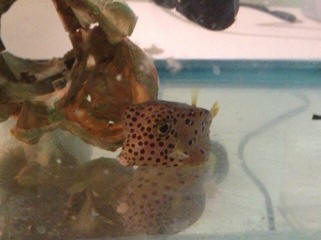
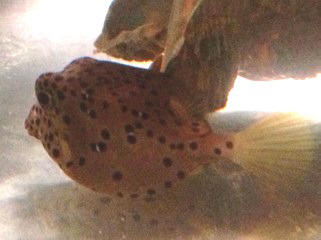 |
|
Emperor Angel blotchy, not eating while other fish are fine.
Stress/induced, and poisoned by med.s 2/5/13
Please help!
Hi there
<Faheema>
Thank you so much for always being so incredibly polite and informative
- I've learnt so much from you guys! I need help. I have an Emperor
Angel who is refusing to eat and has large white blotches over his body.
They seem to fade as the day progresses but I've attached a picture of
what he looks like first thing in the morning.
<I see this... and the other angel>
Recent events: I had a run of white spot which I treated with Cupramine
about four months ago. I did this in my display tank, which resulted in
a collapse of my bio filter.
<Common occurrence>
I struggled to get my nitrates down but it eventually budged with the help
of an overpowered skimmer, Nitraguard titanium cubes, special blend and
lots of water changes. The white spot returned and I decided to not
treat it with anything this time.
<Good>
Its been three to four weeks and I can only see a few signs of white
spot on some of my fishes' fins. They are all eating except for the
Emperor.
I would have assumed that it was just another bout of white spot but my
regal tang who is usually riddled with it is absolutely clear and not
scratching one bit.
The Emperor isn't scratching, but visits the cleaner wrasse and shrimp
often. he also has cloudy eyes and it seems as if there are some stringy
bits around his eye. His fins look a bit frayed and he is covered in
white patches (see photo). I gave him a FW dip two days ago but couldn't
see any flukes. It also didn't seem to change his behaviour at all.
He is in a 125g FOWLR
<Needs more room than this... particularly if you're going to keep the
Holacanthus ciliaris with it... At least twice this volume. I'd get a
300 gallon plus>
along with 1x 5yr old Regal Tang, Adolescent Queen Angel (not sure of
age), 3 x yellow tangs (Medium size), 1 x Auriga butterfly, 1 x blue
cheek goby, 1 x cleaner wrasse, 3 x small ocellaris clowns, and a neon
goby. Also have 2 x cleaner shrimp and a pumpkin urchin. (I'm
upgrading in the next two months, but for real.:))
<Ahh! Or separate the Angels>>
I also recently added a bi-colour angel and a Naso tang
<... there's no room for more fish/es here... and you have a still
resident/active Crypt infestation>
(both quarantined for six weeks) and they died within three days after
being added. Soon after that one of my blue cheeks died and this is when
the Angel stopped eating.
Water parameters:
Ph: 8,2 , Alk: 10.0, Sal: 1,020,
<Too low...>
Nitrate: 10-25, Nitrite: 0, Ammonia: 0, Temp: 24 - 28 degrees (on very hot
days)
System: 125g with sump, Super Reef XP-5000 Ext cone skimmer,
phosphate reactor.
<Not a fan; see WWM re>
(I usually run ozone through an ozone reactor but the ozonizer has
malfunctioned and I'm waiting for it to be replaced). I've just ordered
a chiller as I've been getting some temperature spikes of up to 28
degrees Celsius.
<Ok>
I'm currently dosing with Metronidazole.
<Shouldn't/can't be used continuously... see WWM re... Stop!>
I'm doing some extra water changes and adding stability and Special blend.
I'm also dosing with some VITC and VITM in hopes that it might
supplement his diet. I suspected Velvet as well,
<No; all fishes would be dead>
but my I got my LFS owner to come and take a look and he couldn't see any
signs on it on the other fishes.
I'm incredibly attached to this fish as he's been there since the start
of my tank. ( Just over a year ago).
Thanks so much!
<... Well, the best course of action is to move the Emperor
elsewhere.... where it will be less stressed. I encourage you to use
Spectrum pelleted food as a staple... And stop medicating. Bob Fenner>
|
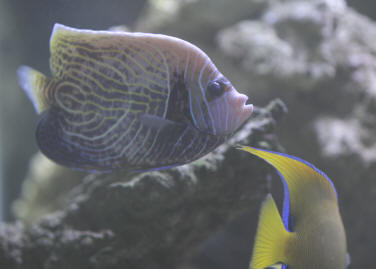 |
Help. Domino Effect Chemical Disaster
9/7/12
Hi WetWeb Crew!
<Hello Christine>
I must be honest, I am almost embarrassed to be writing in with this issue, but
for the sake of my cherished aquarium... Well you know, I will go to great
lengths.
I thought my problem began with my maxima clam jumping all over the aquarium,
and possibly losing his byssal filament, however whatever is going on with my
clam may be the result of another issue I had months ago that I thought was
resolved, and here is my shame.
It started with a huge macro algae bloom in my aquarium, I keep most of my macro
in my sump but do enjoy a piece here and there in the display tank tucked behind
a rock as it adds a little height and movement. But it literally bloomed
to where it was choking out my corals, my nitrates were sky high and I couldn't
figure out why so I kept doing water changes. Long story short, I
ended up bringing my whole r/o unit into my lfs only to find out that the TDS
meter was faulty. Everytime I did a water change I was adding more and
more nitrates into my tank.
<Happens>
I Changed out all my filters and di resin and corrected that problem, but
obviously created another with the large amounts of macro algae die off that I
was grabbing out by the handfuls for days and days so that it would not rot in
my aquarium.
I do regular water testing, but rarely test my PH, another big shame. I
assumed that since my alk was good at around 7.9 or 8, (good range for a clam I
was told) that my buffers were doing their job. You must be shaking your
head in disbelief by now.
As my clam was still hopping around I did full water testing
Calcium 500
<Mmm, too high>
Phosphate 0
Alk/dKH 8
Mag 1480
Nitrate .20
PH 7.4. Uh oh
<Yeeikes>
So I did a lot of research on line to try and figure out why on earth my PH
would be low and my alk be ok. Since I do not have a calcium
reactor, the only item that applied to me was low oxygen or high co2.
I do not have a glass canopy, or any canopy for that matter, but I did open the
window in the room where the aquarium is, adjusted my powerheads and overflow
returns for max surface tension, removed some pvc pipes leading into my sump so
the water now dumps into my sump rather than flows quietly through a pipe.
I have lowered my salinity to just between 1.023 and 1.024 and lowered my temp
from 76 to 74. At some point today I will be purchasing the right size
tubing to attach to my protein skimmer to allow it to suck air from the room to
make bubbles rather than using the sump water. And will add a fan as well.
I have heard that ph tests can often times be wrong,
<Not often, no>
so I took my water to my local LFS and had it tested, it showed the same
results that my test showed.
Next, and this being the only other thing I could think of, since I have a
Salifert kH/alk test, I ran the check solution. Well low and behold the
check solution should have been 6.7 tested at 9.3! So i have been getting a
false reading for my alk for quite some time, in which it appears higher than it
actually is. I quickly ran out and purchased an API kH test and confirmed
that my readings were somewhere around 100 ppm. Now my head is swimming.
So I have been dosing over the past 48 hours with b ionic to increase my alk.
It is still low, according to the API test it has increased but only within a
range of between 100 and 200 ppm. I have been dosing every 24 hours to increase
on a consistant basis and not all at once.
So now you may be asking why I bored you with all that useless information about
oxygen in my tank. Well the reason for that is because while my alk is
rising, my ph has not budged at 7.4. I understand it probably doesn't
adjust proportionately, but I performed an "oxygen test" by removing a cup of
water from my aquarium, placing an airstone in it for a few minutes and
rechecking the PH. In just those few minutes, my ph boosted to 8. So I am
still thinking I have a problem. And incidentally, which I also believe
has something to do with this whole situation, a friend of mine set up some
aquariums around the same time I upgraded from my 90 to 125. Maybe 8 or 9
months ago. I went to visit this week and the back of his aquariums are
loaded with coraline algae. I have none. Not even a little.
I know that low alk and ph make it difficult for calcium to be absorbed.
<This is so; yes>
I have reached my limit of knowledge and understanding of water chemistry for
now, and am now turning to you for expert assistance. I can get my alk up
to where it should be, but my ph is not moving.
<Don't worry, obsess re this... it will "come up" in time>
Other than what I mentioned above, I know of no other way to raise the o2,
except by using Kalkwasser to push out the excessive co2.
<Mmm, well... IF you want to further your physics, chem. knowledge, practical
application, you might consider adding an ozonizer (and measure for RedOx)...>
But I have no understanding or experience with Kalkwasser and read it can
actually cause damage if used improperly. And don't know if a one time
shot would be the answer.
<One time? Not really worthwhile unless one is just trying to precipitate out
phosphate>
I don't have so many corals that dosing is no longer an option. I
actually prefer to dose over having a calcium reactor.
<Okay>
Incidentally my mother, who has been recently diagnosed with lung cancer, (and
yes I may have not kept up religiously with aquarium maintenance during this
time, but managed the bare minimum) has offered use of her oxygen for a
few hours (she is NOT on liquid oxygen) if that would help infuse oxygen into my
tank and raise my PH.
<Not the route I would take, no>
The woman is a saint. However tempting as this is, I suspect that
it would only be a temporary fix even if it is a feasible idea just as adding an
airstone. I need to find the root. What else can I look for, do or test?
<Solutions... like adding a good deal more easily soluble substrate (DSB) in the
tank, sump...>
I have not been dosing calcium so I am not sure why it is at 500, unless it is a
by product of decay created from animals not being able to absorb the calcium
correctly. Or my Salifert calcium test is also inaccurate. My
lfs is retesting ALL of my result this evening when they open. Going
forward I will always have separate tests to use as confirmation for all my
testing.
And I will not assume a test is accurate just because it is expensive.
But for now, if the bottom line is that my PH remains low, as all my other
chemicals are coming back into balance, what in the world does that mean and how
do I fix it?
<Again, not to panic. Do read a while here:
http://www.wetwebmedia.com/mphtrbl.htm
I raised my clam up as well, and he has not hopped around off this higher rock.
I don't think he anchored himself to it though. He is still a beautiful
color and opens, but his mantle seems flimsy and he does not seem as quick to
respond if I wave my hand over him. But he is not dead yet and I will
continue to fight for his survival, as well as everything else in my tank that
is being affected by this imbalance.
Thank you,
Chris K
<Take your time... Bob Fenner>
Re: Help. Domino Effect Chemical Disaster
9/23/12
Hi Wet Web Crew
<Christine>
Just an update and a few more thoughts regarding my chemical imbalance
issues. Firstly, I am happy to report that I have not lost my
clam. He did re-anchor himself for a week or so, then moved again.
I have since altered my lighting schedule and moved him up to mid tank
where I am happy to say he has not moved from for a week or so, however
I am quite sure he has not anchored himself again as of yet. Sigh
<This takes time>
Sadly I am relatively certain my sandsifting starfish did not make it
through the PH ups and downs.
In a nutshell, I have added more substrate, began aerating my rodi
water for 24 hours prior to adding the salt, increased the frequency of
smaller water changes to try and lower the calcium levels and have been
dosing almost daily to try and maintain alk of at least above 8 and
magnesium above 1200 to no avail.
<Something is up here... we need to start back "at some beginning">
I have replaced my test kits and double checked their results with my
LFS, and purchased back ups so that I could continue to double check my
results at home.
In total frustration I began earnestly reading your sight to find
any commonalities with other people who are having similar issues,
when lo<w>
and behold I found a whole thread dedicated to Coralife Reef Salt users
who are experiencing the same types of issues. I have been using
Coralife Reef salt since I upgraded to my 125 about 8 or 9 months ago.
So I mixed a batch to 1.026 and measured it. Alk was 7.4, Mag 1170
and calcium 500 (at least, as my test only goes up to 500).
I think the mystery has been solved.
<I do agree>
My tank contained mostly soft corals and a few LPS that all seemed to
look good, so I never did much water testing, that is until I got my
clam and began to notice these issues. Now in hindsight I am
beginning to notice things with some of my LPS corals that make me say
hmmm. Such as big heads of candy cane coral in which
the polyps seem to continually divide and divide, but no new branches
ever form. I could not frag them if I wanted to, as I may have up
to 7 heads on one branch. I have never seen them like this in my
LFS. That, and the lack of any coralline algae which I mentioned
in my previous email. Perhaps the high alk and low PH is the cause
of all my Zoanthids dissolving?
<Could be>
Regardless, in reading your sight <site> I see that Tropic Marin appears
to be a good reef salt, if you have any other suggestions it would be
greatly appreciated.
<This is a superb, consistent product>
But before I change to that, do you think there would be any benefit in
using a non reef salt, like instant ocean marine salt, for several water
changes, due to its lower concentration of calcium in order to lower my
calcium faster?
<Worth trying, but I'd go w/ the TM product directly>
I realize it also has lower Mag, but I could temporarily keep that
balanced by dosing if necessary.
<Yes>
Thank you,
Chris K
<Cheers, Bob Fenner>
Re: Help. Domino Effect Chemical Disaster 9/23/12
Bob,
<Chris>
Thank you as always for your response. You mentioned that something seems
off, and needing to go back to "some beginning". I am hoping that my
lack of testing when my tank contained mostly softies, and then my
subsequent upgrade to a larger aquarium and change to what I believed was a
better salt mix at the time was the actual beginning. Incidentally, I used
Reef Crystals prior to my upgrade and the sides and back of my prior tank was
covered with coralline algae. I believed at the time everything "looked"
good, hence the lack of testing. I hope that sounds about right, because
throughout this ordeal I believed I had found the beginning of my problems
several times, only to continue to trace it back even further.
<Sorry re... am very tired, from camping, driving... the "something" is almost
certainly the suspected salt mix>
I do apologize for my previous spelling errors. I believe I was a
little bleary eyed from reading so much.
<I do understand>
And again I thank you so much for your help. Your site is invaluable and I
am certainly hoping you don't become disheartened with regulars like me.
<Not at all... in fact, it is because of intelligent, sensitive persons as
yourself that we produce WWM>
Hopefully I will see improvement from this point on, and will be happy to let
you know.
Chris K
<BobF>
|
Puffer air bubble? 4/23/12
Hi, Based on scouring your FAQs on puffers, I think my puffer fish (who I've
had for six years now) has an air bubble.
<Mmm, much more wrong here... the "crew cut tang" as well show signs of poor
environmental stress and mal-nutrition>
I'm not sure though since most of the FAQs suggest that a puffer can't
survive very long with an air bubble, and mine has endured this problem for
about 3-4 months now. My puffer has trouble swimming upright, and often sits
on the ground upside down now. I've tried gently rubbing his belly but
he always puffs immediately. Based on looking at the attached pics, what do
you think? Is it an air bubble? Any remedies you would
recommend?
Thanks, Ethan from Massachusetts
<... re-read re Burrfish and Zebrasoma diseases... these fishes are doomed
otherwise. Bob Fenner>
|
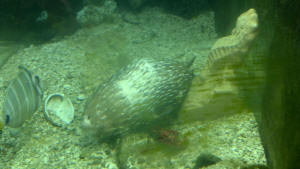
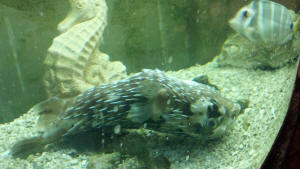 |
Oxygen problem... Mmm, something
else 8/30/11
Blonde Hi there Crew,
<Interesting>
I just wanted to say thanks for all your info!!! I have a 180 gallon
tank full of coral, invertebrates, 150 pounds of live rock and fish. My
fish include Emperor Angel,
<Will need more room in time>
Naso tang, 3 green Chromis, 3 fire fish, starry blenny, fairy wrasse,
three pygmy angels, yellow and blue hippo tang. I have a few pieces of
leather coral, hammer coral, mushrooms, three candy striped shrimp and
lots of turbo snails and crabs. I know the tangs and emperor will out
grow my system that is why I am planning to buy a 300 gallon tank in a
year or two.
<Ah good>
All Tangs and emperor are four inches long. Everybody else are babies.
I bought them small so they would grow up together. My tank is over
stoked <and stocked> and I know this. I do a 25% water change
every Sunday. I test my water quality every Wednesday. I have noticed
lately my fish have been breathing hard lately and having Ich break
outs from the stress of low oxygen. The invertebrates and coral is
<are> doing great. I think because they don't require as much
oxygen as the fish do.
<May be>
I have two Rio 1100 power heads. one of black magnetic power heads(not
sure of brand, but it moves the water) 50 gallon sump, and skimmer. I
took my tops off the tank to help release gases, I pointed the outflow
from my sump to the top of the tank to help with the oxygen. I put the
magnetic black power head on the upper right side of my tank pointing
towards the middle of tank,
<Better to arrange the water movement as a gyre>
I put the two big ugly Rio power heads on the back of tank pointing
down towards the bottom of my tank. All this and the fish are still
breathing hard!
<There are dissolved oxygen tests... colorimetric, titration,
electronic...
Maybe your dealer/s have one of these to lend. I suspect something else
is at play here>
I hook up a air flow tube to one of the Rio power heads to help with
oxygen and did not help. All it did was stress the fish. I was going to
buy two more power heads today and put those at the bottom of my tank.
I am about ready to have a Ich breakout myself from the stress of my
aquarium.
Please help, Jim from Idaho
<Either some common protozoan complaint... e.g. Crypt or endogenous
poisoning... the Sarcophyton fighting w/ the Euphyllias, perhaps
Shrooms... I would add a good deal of high quality activated carbon
and/or Polyfilter to your filter flow path... And for the size/type
system you have, look into RedOx, getting and using an ozonizer... for
several reasons/desired benefits, including DO. Please read here
re:
http://wetwebmedia.com/redox.htm
and the linked files above. Bob Fenner>
Re: Oxygen problem 8/31/11
Hi Bob, The blonde was suppose to be next to the Naso Tang.
<Oh!>
You were right about the problem. My Nitrate was 90%!
<... ppm I take it>
My lfs told me to use Salifert all in one, and Micro Bacter 7
Bioculture every time I do water change.
<Mmm, unnecessary>
I think I have overloaded my system with it. I did a 25% water change
and put Charcoal back in my system. The Nitrate has gone down 45%. I am
going to do another water change today and hopefully everything will be
back to normal. I keep getting all this crap to put in my system from
my lfs.
<I am of the opposite philosophy/practice... I encourage all to put
in the absolute minimum... and ONLY products w/ ingredients labels of
chemicals they CAN and WILL test for>
I read I should add Salifert all in one every week is this true? Jim
from Idaho
<I wouldn't add whatever product from this fine company period,
unless it is necessary. Bob Fenner>
Extreme Overheating Question
7/23/11
Dear WWM Crew,
I've been maintaining a 5500 gallon fish only saltwater system with
4 display tanks. This past week we had a heating malfunction and the
heat pump unit ran the system temperature up to 104 degrees for about
18hrs.
<Yeeikes!>
Of course everything was a complete loss. The temperature is now back
to normal (77-78 degrees) and changed 10% of the water volume today and
preparing for another soon. Now my question is, what else needs to been
done prepare the system for replacement fish and how does this extreme
high temperature affect the biological system that was in place.
<Mmm, perhaps the use/addition of chemical filtrant for the
possibility of the last>
System is as follows: All tanks have a 2-3" sand bed, the main
display (4000-gallons) has about 2000-lbs of base/live rock, the filter
system is sump with filter socks (14), two large inline pool type sand
filters with carbon in each (appro-200lbs of carbon in each filter), a
RK2 PE-150 protein skimmer with Ozone Generator (2500-MG/day), and a
330-gallon bio-sump filter with kaldness media for the
biological and a Emperor Aquatics inline UV sterilizer. I have never
had this happen before, never heard of this extreme of a case of
overheating, so I am very unsure how to recover from this.
<Really just time going by>
I will test the water daily and would assume I need to do several water
changes, just needed advise and an expert opinion. Thanks for the help
in advance and look forward to hearing from you.
Thanks,
Shawn
<Take your time re-stocking... and all should be fine. Bob
Fenner>
|
What's This? 10/25/10
Hi Crew,
Hope You All Are doing just fine.
<Hello, and thank you>
First of all I have a 90 gallon salt water aquarium which I
cleaned
<Mmm, define "cleaned".>
yesterday and this morning when I woke up (around 7-8 am)the 4
nemos I have 2 black 2 orange were breathing really fast and they
look like dying, I started reading the parameters and ammonia was
0, nitrite 0,nitrate 0, alkaline 2.9-3.6 but ph appear to be
below 7.8, so I went ahead to add some ph buffer and alkaline
buffer and turn on the skimmer.
<Mmmm... I wouldn't do this>
I don't really know what it was that cause this, but right
now (3 pm) they aren't on the ground anymore, they're
swimming a little bit more, but they haven't eat.
<Eaten>
I did lose one fish a damsel. However I also have one yellow
watchmen , one scooter and one scissor tail fish, I was worried
about these 3 since I didn't see them, for about 30 minutes
when I found out about this, but now they're out and ok, but
I see that the scooter its having more problem then the other
fish since it barely moves, and breathes slow.
,I don't know what else to do, the parameters are this
ammonia 0ppm,nitrite 0ppm, nitrate 0ppm, ph 8.0-8.2, temperature
27-28,salinity 1.023.
<There is much more to water quality, unfortunately>
I turn off the lights when I saw them like this, I barely turn
them on about 1 hrs ago, if I see they go to the ground again I
will shut the lights off, somehow when they "sleep"
they tend to breath less therefore whatever that's causing
this problem wont happen as fast.
My question is, sorry it probably doesn't have to do with the
whole problem I had but, I don't know what are those worms, I
added the pictures, I barely notice this worms today, they're
below the sand.
<Yes, Polychaetes (Errantiate);
"Bristleworms">
Thank you, and I hope you can give me more advise towards the
problem I had, I had cleaned before and they had been fine for
about 4 months.
Ingrid Leija
<Please read here: http://wetwebmedia.com/polychaetes.htm
and the linked files above and here:
http://wetwebmedia.com/marine/maintenance/marineMaint.htm
to give you some background in "appropriate" strategies
for "cleaning"... I suspect your work here may be a bit
too vigorous. Bob Fenner>
|
|
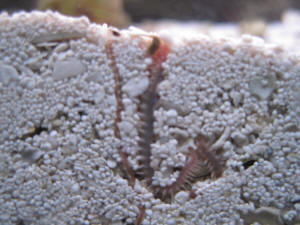 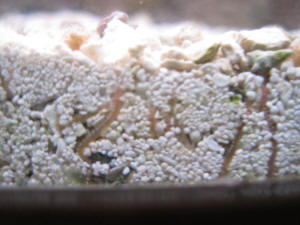
|
Please help!!! New tank, new tank problems. SW, env.
9/22/10
Hello,
<Hi>
I have recently started a new tank which has been up and running for
about a month now. I have clowns, damsels , a bright red starfish with
a black grid-like pattern, a coral that has a tree branch like
appearance and an anemone with a pink base, tips and green tentacles
(sorry for the vagueness).
<Did you cycle this tank? How large is it? An anemone has no
business in a tank this new as they require stable water conditions and
a mature tank.
Also mixing anemones and corals in most tanks is a bad idea. Starfish
are also sensitive to water quality issues and need established, stable
tanks.>
Everything has been so far so good except I returned from work this
evening to find the anemone severely shriveled, the starfish curled and
the branch-like coral closed up. The damsels and clown fish are
perfectly fine but I'm very concerned for the corals and star
fish.
<Probably a water quality issues.>
The temp is approx 25 degrees and the gravity 1.023-1.024. I have
misplaced my pH level testing kit so until I buy a new one is there any
obvious solution to help them!?
<Ammonia, nitrite and nitrate reading? I'm guessing your issues
are environmental in nature.>
Thank you!
<Time for some reading, start with these and related FAQs
http://www.wetwebmedia.com/watrqualmar.htm
,
http://www.wetwebmedia.com/marine/inverts/cnidaria/anthozoa/anemones.htm
,
and here for a list of topics http://www.wetwebmedia.com/marine/index.htm
.>
<Chris>
Re: Help....Blue Tang 5/13/10
Hello Dear Mr.'¦..
<It's actually Dr. Neale Monks, but here, you can call me
"Neale".>
Today I noticed something wrong with my Blue Tang it is scratching her
body with the rocks.. it has a little brown Spot on the
body'¦. And I am so afraid for the others.. of the
infection'¦specially for my emperor angle fish that still
doesn't eat'¦
<The problem is ALMOST CERTAINLY environmental. You MUST buy and
read an aquarium book in your language. I honestly cannot offer you any
better advice than this. If one fish is sick, you may be unlucky. If
two fish get sick, then the problem is with the aquarium. It is
crucially important you check salinity, water chemistry, water quality,
and temperature. You have given me no information on your aquarium, so
I cannot say anything useful.>
Please what can I do'¦.
<Read.>
Some body Advice me to give them a fresh water bath.
<Why?>
all my fish'¦.is that right .....How can I do this
correctly'¦
<Honestly, I fear for these fish. You haven't said anything
about your aquarium. I'm worried you don't understand what they
need. Both the fish species you mention are difficult to maintain. They
require expertise. You MUST read. Cheers, Neale.>
Re: Help....Blue Tang 5/13/10
*Hello Dear Dr. Neale*
<Just "Neale" is fine.>
Here is My Aquarium Specification: 850 liters of water with wet dry poi
logical filter included Balls'¦.With protein
skimmer'¦
<Sounds fine.>
Salinity Between 1.020 and 1.030
<No! This is dangerous! The salinity must be constant. SG 1.025. Not
1.024, and not 1.026. Must be 1.025, every day!!!>
0 ammonia, 0 nitrite
<OK.>
temperature** 27.C
<A little warm; 25 C is best.>
Have 6 Small Blue Damsel
One Yellow Tang
One blue ragger
<Don't know what this is.>
One Emperor Angel fish
One Tomato Clown
<Can I suggest you start reading here:
http://www.wetwebmedia.com/marsetupez.htm
http://www.wetwebmedia.com/spg_salinity.htm
If you salinity is varying between SG 1.020 and 1.030, then that could
EASILY be killing off filter bacteria, and placing a HUGE stress on
your saltwater fish. My specialty is brackish water fish, and salinity
variation is something those fish handle. But coral reef fish come from
the most constant, unchanging places on Earth. They HATE change!
Cheers, Neale.>
Re: Help.... where does this go?
5/13/10
so what should I do now
<Do a series of small water changes, perhaps 5% aquarium volume per
day, until you get the salinity to SG 1.025. Don't try and do a big
water change, because that will stress the fish and the filter
bacteria.>
until now you do not tell me what to do first.. to save my tank..
<I have no idea how to "save" your aquarium. If your
salinity is varying between 1.020 and 1.030, then that's the reason
your fish are sick. Tangs and Angelfish are intolerant of poor aquarium
conditions. Provide good water quality and they will feed. If you do
not fix the environment, they will get sick. There is no medicine that
will fix this. You MUST make sure the aquarium is properly maintained.
That means -- among other things -- a constant salinity level.>
I gave you every thing you asked for
<Yes, and I told you what was wrong. Forgive me, but it is difficult
for me to help if you cannot read the WWM articles. Cheers,
Neale.>
Hurt Fish'¦ Sometimes Less Is More --
03/26/10
Good morning.
<<Hello>>
I have a hurt six line wrasse, he's a little over an inch long.
<<Wow'¦tiny>>
He was missing last night and I finally found him wedged under a
rock.
<<Mmm'¦>>
I moved the rock and he swam away and immediately settled in a hiding
place and has been there ever since.
<<Stress'¦and likely physical injury>>
I didn't expect him to be alive this morning, but he is. His eyes
look like they've had some vessels burst behind them, so I'm
afraid this is very grim for him.
<<Possibly>>
Is there anything I can do?
<<As much as it sometimes pains us to see our fishes in distress,
sometimes the best action is no action. Often in such cases as this,
any attempts to 'help' only cause more damage'¦and
certainly increase stress (on both the fish and you). As long as this
fish is not being harassed by other tankmates, your best bet here is to
leave it be and let it heal on its own (if it is going to). But, do
re-evaluate your rockscape and see if you can take action to prevent
another such incident. Cheers'¦ EricR>>
Feather Duster question... Mis-stocked mess, no reading,
news at... Oh, we don't have news in the U.S. any longer .
Propaganda and "entertainment" at 11:00 maybe
1/02/10
My husband has a well established salt water reef aquarium of 55
gallons.
He recently purchased a Hawaiian feather duster that seemed to be
attached to the reef for the last week to 10 days. When we awoke this
AM, this particular feather duster was not in the same place it had
been for the last week to 10 days.
<Quite common experience>
It was laying in the back of the tank on the floor, but survived. Can
you think of any reason that it would become unattached and moved that
far from the original location?
<Looking for somewhere better to be>
We have in this reef tank:
2 percula clowns
1 yellow tang
1 blue damsel fish
<Likely a social species... Chrysiptera sp., perhaps a Chromis
sp.>
1 sand sifting goby (quite large 3-3.5 inches)
1 coral beauty
1 fire goby
<Ditto>
1 sally lightfoot crab
1 cleaner wrasse
<Not for long if this is a Labroides sp.>
1 cleaner shrimp
several small hermit crabs
several small snails
1 Chromis
<... see WWM re>
1 med-lg Hawaiian feather duster (other than the one that moved)
In this tank we also have a green Goniopora that reproduced about 3-4
weeks ago and the offspring is no longer visible.
<Likely a "bail out" process... this genus is a long time
"loser" in captivity. See WWM...>
We had moved it from the floor of the tank to a small crevice in the
reef when it disappeared. Where could it have gone? Would any of the
other animals in the tank have anything to do with the tube and feather
duster moving or the baby Goniopora disappearing?
<Mmm, could be; yes. There are a few fishes you list that might be
involved>
Any information you can share to shed light on these occurrences would
be greatly appreciated.
Sincerely,
Patricia A Starr
<Read here: http://wetwebmedia.com/featherbehfaqs.htm
and elsewhere on WWM (the search tool, indices... you will find
instructions where you found where to write us) re the other life you
list.
What you have currently is untenable. Bob Fenner>
Attn: Bob Fenner... Reef trouble... hlth. diag.
9/1/2009
Bob,
Hey..How are you?
<Fine thanks>
Its been awhile since my last email. All has been well with my Reef
tank until 4 days ago..
I have a 49 gal cube tank with a 10 gal sump and 10 gal refugium. My
fish are Two Spot Bristletooth tang, a mated pair of True Perc Clowns,
a Banggai Cardinal, Orchid Dottyback, and one yellow tail damsel who
lives in the Fuge. My corals are mostly mushrooms, Zoas and 2 orange
Monti caps.
Over the past 3 months I had been battling Dinos, which up to about 2
weeks ago started to fade out. Allot of my cleaning crew had been lost.
So 4 days ago I added about 40 nass snails
<Wow>
and 30 periwinkle snails
<Too many...>
and some larger turbo snails. Up till I added the snails, all the fish
were very active and eating well. It seals like since I added the
snails, The Dottyback hasn't came out of his cave in 4 days, and
both my clowns have pretty much stop eating and are very lethargic.
<Mmm, do you suspect something "came in" with the
gastropods?>
Normally whenever I put my hand in the tank anywhere near where the
clowns lay their eggs, the male would bite at my hand. Today I stuck my
hand right by him and he pretty much hovered over my hand. Both clowns
look like they can barely swim. I'm ready to put both of them in a
hospital tank.
I took a flashlight and shined by the Dottybacks cave...he just laying
in one position barely moving. If I stick my hand by there, he will
swim around and move like normal. But then returns back to his same
position in the cave. The Dottyback has also stopped coming out to eat.
When I acclimated the snails,
Before I added them, I rinsed them off with tank water.
<Mollusks of many kinds are vectors of parasites of MANY
kinds>
The tank has been set up for a little over a year and I've added
snails many times with no problems.
My water parameters are as follows:
Salinity - 1.025
Ammonia - 0
Nitrates - 0
Nitrites - 0
PH - 8.6 ( i know kinda high)
Alk - 13 dKH
Calcium - 420
Phosphate - 0
I do 5 gal water changes weekly with 12 stage filtered RO/DI water, I
run my skimmer 24/7, and I have a Phosban reactor which I run carbon.
But I haven't had going in about 3 weeks. Should I move the
affected fish to a hospital tank?
<I would try some (serial, daily) large water changes myself... but
have the other tank ready... And I'd remove most of the
snails>
I would appreciate any help you can give me...Thanks!!!!!!!
<Welcome. Bob Fenner>
Aeration and massive fish kill 8/12/09
I have a 200 gal reef aquarium, built above a bar, so the water level
is about 7' above ground. Geometry is a bit too deep for surface
area (L shaped tank) as the tank is Plexi and the two covers have about
a 1/2 in. gap for air exchange. Lighting is enclosed with forced air
ventilation (actinic & metal halide). 25 gal sump with mechanical
filter and protein skimmer.
Separate bio filter with own circulation. Additional mechanical filter
with own circulation. Main circulation from a weir through sump at
1400gph.
Tank is 3 years old. Lots of live rock, snails, hermits, serpentine
starfish, bubble tip, and:
Hippo tang
Flame Hawk
4 Damsels
Sail Fin Tang
Chrysurus Angle
Striped Wrasse (2)
Sergeant Major (2)
Neon Dottyback
For first 9 months, fought dropping ph. Alkalinity way too high for
ph.
Tested container of water with aeration while monitoring ph. Yep, rose
very quickly. Too much carbon dioxide (carbonic acid generation).
<Not uncommon.>
Put a couple of air stones in sump with small aeration pump. Helped.
Got 6 CFM linear air pump, large aeration stone, and installed in sump.
Put pump outside for less CO2 in source.
<Good>
Tank ran great for next 2+ years.
Linear pump died, so ordered another. Replaced with small "air
bubbler type" pump until new one arrived.
Normally clean/10% water change each week, but schedule resulted in a 3
week cycle.
Got new pump, installed. Next day (yesterday) all but a small Sergeant
Major were dead! No problem with inverts.
<!>
Full chemistry showed nothing! ph 8.2; Nitrate .5ppm; 0 ammonia and
nitrite; SG 1.025; No copper; temp 79 (chiller installed). Did have
higher than normal smell of nitrogen from bio filter flow.
Any idea what happened?
Ralph
<Only a general guess... some sort of "wipe out syndrome"
that did not affect the invertebrates, and left the one, hardy damsel
extant amongst the fishes. Please read here re:
http://wetwebmedia.com/toxicwipeoutf.htm
and the linked files above. Bob Fenner>
Re: fish death 8/13/2009
I'm unable to find Poly Filters here at present time the available
products
I can get are Purigen and Chemi-Pure. Will either of these products
work?
<For the purposes of toxic removal, yes. For diagnosis of
identification by colour, no. Bob Fenner>
|
More Re: Cardinal gill problem 11/13/08 Hi
Scott, Thank you for your response. <Welcome Wendy.> I
haven't added anything new for quite some time. No painting
or spraying of any kind is allowed near the tank, not even to
clean the glass. I use a refractometer to test my SG and it's
been calibrated with RO/DI water. Since he's acting normal
otherwise I'll wait for a response from Bob. <I will drop
this in his box right now. He is only a day or two out at this
point.> Thanks again, Wendy <Thank you, Scott V.>
<<Most "cases" in which there appear to be
"hard breathing", more or less permanent distension of
gills are due to issues of gas distribution (low DO mostly,
Dissolved Oxygen) or some sort of in situ poisoning... I see that
there is appreciable Blue Green Algae present in this system...
this might well "be it" here. Please see/search WWM re
BGA et al. toxic effects. Perhaps start here:
http://wetwebmedia.com/toxictkendof.htm Bob Fenner>>
|
 |
|
|

